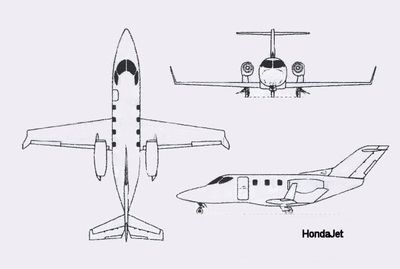I agree with Adam. It should reduce drag caused by shock waves resulting from airflow locally exceeding speed of sound. Not that it’s the only element in the efficiency equation.
AdamFrisch wrote:
I think it’s a spectacular little jet. If I had that money and was shopping for a VLJ, I’d put it high on the list.
I quite like it too. Although they could have made it even more potent. I can’t help but remember the old Falcon 10. What a beast.
Martin wrote:
It should reduce drag caused by shock waves resulting from airflow locally exceeding speed of sound.
The HondaJet has a maximum speed of Mach 0.7 – shock waves are not a major factor at those speeds yet.
what_next wrote:
The HondaJet has a maximum speed of Mach 0.7 – shock waves are not a major factor at those speeds yet.
Well, few seconds of searching reveals this paper. Since you might be into the details.
Martin wrote:
Well, few seconds of searching reveals this paper.
Maybe, but their study (and especially the relevant results, see for example fig. 22) is for the “transonic regime” and really starts at Mach 0.75, a speed which the Honda Jet is not built for.
Looking at 3-view drawings, the engines could as well be mounted on the fuselage. IMO it is practical considerations. The fuselage (interiors, future changes etc) becomes more flexible and easier when the engines are mounted on the wings.

what_next wrote:
Maybe, but their study (and especially the relevant results, see for example fig. 22) is for the “transonic regime” and really starts at Mach 0.75, a speed which the Honda Jet is not built for.
You’re right. Lower wave drag is a benefit of this configuration which stuck in my head. But another one is lower interference drag which is what’s relevant in this case. Compare configurations 5 and 6.
LeSving wrote:
Looking at 3-view drawings, the engines could as well be mounted on the fuselage.
Except the inertial load path would then go from the wing or landing gear, through the wing root, across the fuselage wall and back out the horizontal pylon to the engine. As it is, the load path goes from the wing or landing gear straight up to the engine. I could see that saving some material.
LeSving wrote:
IMO it is practical considerations. The fuselage (interiors, future changes etc) becomes more flexible and easier when the engines are mounted on the wings.
I think the biggest advantage of this configuration might be bigger and supposedly also quieter cabin. After all, I think it’s the smallest jet with externally serviceable lavatory. Although burning less jet fuel certainly doesn’t hurt. And if it enabled them to make the airframe lighter, more payload is sure nice too.
Martin wrote:
But another one is lower interference drag which is what’s relevant in this case. Compare configurations 5 and 6.
That could be a factor of course.
…supposedly also quieter cabin.
I don’t believe in this one because the distance between the jet intakes and the cabin is the same as in a tail mounted variant. And there is not much noise tranmitted through the pylons. The biggest source of noise in a bizjet cabin comes from the air flow over the cabin and into the engines.
I think it’s the smallest jet with externally serviceable lavatory.
But this is a pure marketing gag. The thing I fly at work has more endurance but the toilet gets rarely used. Once or twice per year maybe. Cleaning the toilet itself is much nastier than carrying the waste container outside and this always needs to be done from the inside.
The way the engines are mounted on the Honda Jet, engine accessibility might be a much bigger problem. Just checking the oil level before each flight will be difficult enough. On a rear mounted bizjet engine, after undoing a dozen quarter-turn-fasteners, one can remove the entire lower cowling and work on all engine accessories comfortably. Try this on those overwing-engines…
what_next wrote:
I don’t believe in this one because…
I believe they argued that fewer vibrations get transmitted inside. I also think that what really matters is the distance of the engines from cabin. But what do I know.
We have done the cleaning the toilet discussion before. And I’m certainly not interested in performing that duty. But I haven’t seen what they came up with and passengers tend to have trouble wrapping their head around no toilet or even no private lavatory (door, sink, you know, decent facilities which I believe this bird has; hmm, I wonder what is the capacity of the water reservoir). But there must be a reason you don’t see it on smaller jets (cost is perhaps one but I expect space to be another).
You certainly make a good point about access for inspection (and maintenance). However, I would expect them to consider this. Especially as it’s aimed at private pilots.